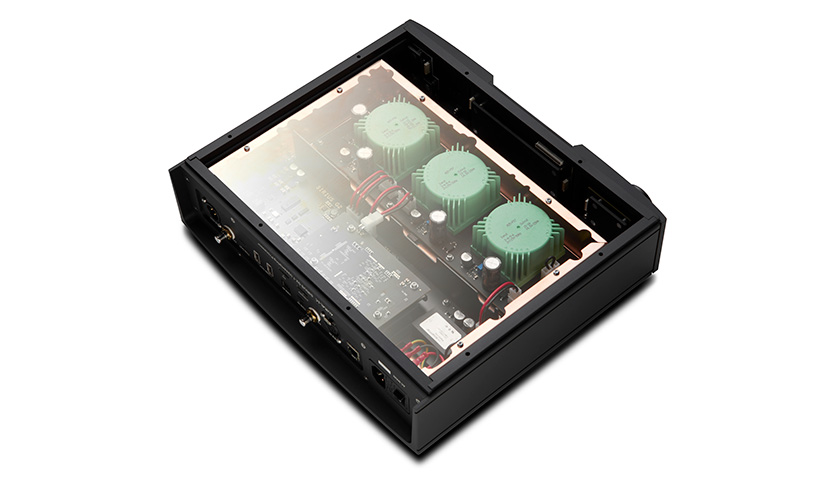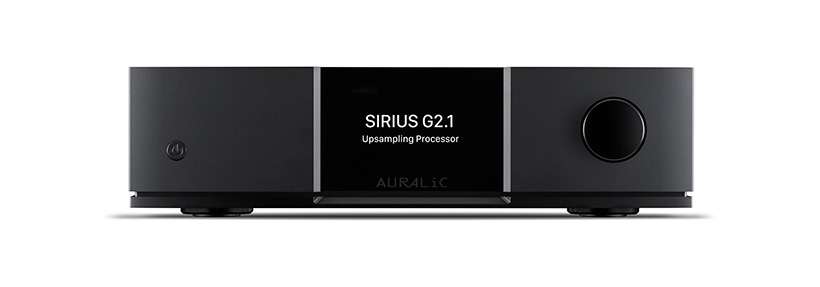This standalone upsampler exemplifies one key difference between digital and analogue systems. With turntables and tape recorders less is genuinely more, the fewer the elements that the signal has to pass through before it gets to the amplifier the less the signal is changed or degraded. With digital sources extra processing such as that provided by a clock or an upsampler actually benefit the end result, it’s a difficult lesson for old school purists like myself to learn but there’s no doubting that more can very often be more when it comes to digital.
I was going to say ‘when it comes to streaming’ but upsampling is beneficial to all digital sources including CD players. Upsampling is nothing new of course, it was being incorporated into CD players in the ‘90s in an attempt to overcome the limitations of that format’s 16-bit/44.1kHz spec, yet it wasn’t always successful when it came to making CD players musically engaging. Today many DACs upsample the incoming signal automatically while a few offer the option to choose between that and non-upsampling which is popular in some circles, my one included.

There are reasons to invest in a more flexible processor like the Sirius G2.1 however, firstly DACs often have what Auralic call a sweet spot, a sample rate at which they are happiest and produce the best sound quality. One would think that higher is always better but higher also means more processing has to be done by the simple computer that runs the converter and inevitably that makes more demands on the power supply, the chipset etc. This upsampler allows you to try different sample rates at the output and find the one that works best with your DAC, it also allows conversion from PCM to DSD and vice versa, and again some DACs work better with one format than the other. Or conversely you may prefer the character of one or the other, I know I do.
The original purpose and possibly more relevant benefit of an upsampling processor like this is to improve the quality of low bit rate/word depth sources. Originally conceived for CD this more even more useful with compressed formats such as MP3. An upsampler cannot recreate the musical data that MP3 abandons in favour of smaller file sizes but it can make the transition from one sample to the next smoother, which results in the music itself sounding less digital. It’s unlikely that anyone would spend the asking price of a Sirius G2.1 in order to listen to MP3 but if you want the breadth of material available on the bigger streaming services (YouTube, Spotify) then a compressed format is what you have to deal with.
The Sirius G2.1 sits between the source and the DAC and has a wide range of digital inputs so that it can be connected to multiple sources if required. Those inputs include coaxial and optical S/PDIF, USB and AES, there is also an HDMI connection for Auralic’s Aries G2.1 streamer using the company’s proprietary Lightning Link. The digital outputs pretty much mirror the inputs albeit there are two USB outputs. It’s worth noting that only the Lightning Link and USB in-/outputs will work with sample rates above 24/192 or deal with native DSD. And good to know that for reclocking and jitter removal purposes all incoming signals are upsampled in the first instance before being output at the desired sample rate.

Sirius is built into Auralic’s box within a box Unity casework where the electronics are contained within a copper case underneath the anodised black aluminium that you can see. The idea being that this protects the signal from wireless interference (RFI), this is one source of the noise in a digital noise floor and the less you have the better the sound. The feet have springs within them in an attempt to keep mechanical vibration at bay because digital circuits are as sensitive to vibration as their analogue counterparts, sometimes more so.
While Auralic’s streamers are accompanied by the Lightning DS control app there is no such luxury afforded the Sirius, which is a pity because it is hugely flexible with many variables that can be changed. It is possible to program the Sirius to accept commands from an infra red remote of your choice, Auralic do not provide one, but the size of the display makes it hard to read when you are at any distance. To change parameters you need to squint at the tiny text on the display where it’s possible to choose between four digital filters, convert incoming sample rates both up and down to a maximum of 32-bit/384kHz or DSD 512, convert formats between DSD and PCM, choose fixed or volume controlled output, adjust balance with a parametric equalizer and even use basic room correction software. The parametric equaliser is unusually flexible with options to adjust up to eight bands and choose high and low pass points.
Sound quality
Listening commenced with the Sirius G2.1 between an APL DNP-SR streamer (essentially a supercharged Auralic Aries) and an Ansuz D-180 DAC using USB connections. Both components are already very good together so it was interesting to hear that the Auralic brought forth more of the music in the form of reverb depth, tone colour and fine detail. It produces a cerebral intensification of the listening experience by bringing a polish to what seemed like a matt leading edges. With the APL as the source and a Linn Klimax DSM acting purely as a digital to analogue convertor the upsampler brought a solidity to piano keys by resolving the weight and definition of the recording to great effect. On Babylon Sisters (Steely Dan) it cuts through some of the excess polish to reveal more of what went into the production, bringing extra interest to an overplayed track by revealing a bit more about the way the drums in particular were played. Taking the Sirius out of this system resulted in a sense of loudness, the sound becoming cruder and more lively. Dropping it back in brings back the subtlety, finesse and plushness of the piece whilst gaining openness. On this occasion the original 44.1kHz was upsampled to 176.4kHz and this helped give the track a pulse rather than a banging beat. Any drummer can do the latter but you need Bernard Purdie to shuffle like that.

Taking the sample rate up to 352kHz added a bit more polish and revealed small details like the character of the guitar and the texture of the bass. If you like nuance you will love this product. With the purist Chasing the Dragon recording of the Locrian Ensemble ramped up to 384kHz from the original 192kHz I was surprised to hear the image scale get bigger and the presentation become more relaxed, softer even. This is a very fine recording that sounds excellent to begin with but doubling the sample rate (and going from 24-bit to 32-bit) made it sound considerably more like the actual event. It’s very rare that a hi-fi system sounds as soft as strings can in reality but this got me closer than usual, a lot closer.
Taking Laurie Anderson’s Gravity’s Angel from 44.1 kHz to 352.8 kHz really pulled the detail out, making for a full bodied, room filling sound where harmonics, reverb and echo were much clearer without undermining timing. This is the area where upsampling usually comes unstuck, or it has in the past, but the Sirius G2.1 can dig out more detail without compromising the sense of pace, which is a key to its appeal. I tried a different approach by cutting out the streamer and connecting a Melco N10 server to the USB input and an M2Tech Young MkIV DAC to the output, this added freshness and detail to the sound for a change but clearly enhanced resolution. Transcoding a 44.1kHz PCM file to DSD512 reduced timing cues but brought a serenity to female vocal and opened up the soundstage. Taking the same track to 352.8kHz did a similar job in terms of tonal beauty but made the rhythm much clearer, and seemed equally expansive and transparent.
Taking a DSD64 file and upsampling that to DSD512 had a similarly relaxing effect and didn’t change the timing of an up tempo Haydn Quartet piece which was clearly enhanced by the processing. Another PCM to DSD conversion proved more positive for the 1-bit format, with a lively track featuring tabla there was a strong sense of the player’s hands and the spring of the drums with excellent pace and separation between instruments. The effect seems to differ between recordings.

By way of contrast I also tried downsampling a PCM file from 176.4kHz to 88.2kHz via the M2Tech DAC, this resulted in a cruder, harder edged sound that had more power in the bass but was otherwise less convincing. Doubling the sample rate to 384 kHz produced a rounded, graduated and nuanced sound with stronger melodic appeal.
Regardless of how one does the upsampling with the Sirius G2.1 the result is greater detail resolution presented in a refined and precise fashion, if you love the minutiae that makes digital music sound like analogue you will find an awful lot to enjoy in this upsampler. It proves that good processing can reveal more of the fine detail in the music and does so in a manner that contributes to musical flow. Equally significant is that while it can be used in an all Auralic system it’s just as useful with sources and DACs from other brands. I did manage to combine it with an Aries G2.1streamer and Vega G2.1 DAC however and that produced a result that was very hard to put down. I am an upsampling sceptic no more.


